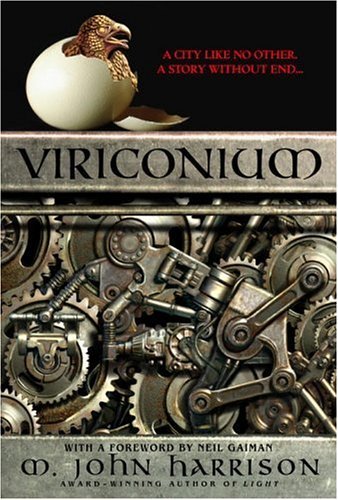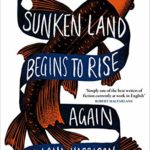From the beginning of M. John Harrison’s A Storm of Wings (1980), you know you’re entering a shattered world with a diminishing human presence, but it is also a dazzling world captured in densely brilliant and beautiful prose. This second novel of the Viriconium series caught me by surprise. The first, The Pastel City (1971), has a recognizable fantasy adventure at its core – a group of heroic misfits come together after long absence to defend a young queen from an invading power – though suffused with the unique imaginings and prose of a great writer.
A Storm of Wings, while revisiting the same world and bringing back some of the same characters, has no such straightforward premise. It is an altogether more brilliant, unsettling and magnificent portrait of a world collapsing in on itself, as the human age is about to be supplanted by the Time of the Locust, an invasion of hordes of alien insects.
A group of misfits once again gathers around the queen, now old and papery in the seclusion of her white tower. There is Tomb the Iron Dwarf, with his exoskeleton and great axe that turn him into a giant warrior; Galen Hornwrack, once a great warrior serving the queen, now an assassin in the Low City of Viriconium; Cellur, the ancient magician-inventor with his robotic eagles; and two Reborn people, recently pulled from a milennial interment in the Rust Desert. They are Alstath Fulthor and Fay Glass, thousand year-old beings who live in waking dreams, have forgotten much of who they were and are “taunted by amnesia of the soul.” But Fay carries a giant insect head in a satchel as well as an important message, but no one can understand her disconnected phrases.
Driven by dreams and strange impulses, they all gather in Viriconium to serve the queen once more, but the journey they set off on, with no clear purpose, is really a metaphysical one across a collapsing world where human consciousness itself seems to be withdrawing from the earth. Everyone seems spent and confused, and great landforms begin to shift and transform. We see this from the opening chapter describing a collapsed obsidian tower which had arisen in a mysterious way and fallen only after ten thousand years.
“Something in the tower’s fall has poisoned the air here, and drained the landscape of its power. White and sickly and infinitely slow, the hemlock creeps out of the water to run sad rubbery fingers over the rubbish in the fallen rooms. The collapse of the tower seems complete, the defeat of artifice accomplished.”
(Viriconium, Kindle edition, location 2461)
The remnants of human achievement begin to merge into an increasingly fractious nature, which itself undergoes strange transformations. At the same time, something hardly noticeable except as a puff of vapor escapes from the surface of the moon and heads for earth. At this point, we don’t know what it is but are told it will change things forever. Before long we link this to the advent of the Time of the Locust and the appearance of insect swarms that fold into the huge shifts in mountains, deserts and oceans.
As soon as I immersed myself (and immersion is the word for it) in the complexly beautiful prose of A Storm of Wings, I thought of other Harrison books. There is a similar strange metamorphosis of nature and people in the world of The Sunken Land Begins to Rise Again, but the parallels are even stronger in his science fictional Light and Nova Swing, especially the latter. In that book, a zone of space called the Kefahuchi Tract intersects with earth, and everything within its sphere suddenly operates under different laws. And people who enter it, often lacking purpose in their lives to begin with, disappear into another existence.
The characters in A Storm of Wings appear broken, mad, lost in memories not their own, glimpsing visions of great insect beings, yet strangely committed to helping each other and trying to move the remnants of humanity to safety or at least a kind of recognition of what is happening around them. As their party crosses a great brown wasteland, crisscrossed by white polluted streams, they seem to sink into a “psychic dislocation” while above them floats the bizarre bloated figure of a former airman named Benjamin Paucemanly. This apparition speaks in a “self-constructed language” no one understands at first, but ultimately he seems to beg them for a kind of release. And that is what these characters seek, each in their own way.
The land, human memory and civilization are in upheaval together, yet Harrison pulls his group of failing heroes into a series of confrontations and recognitions that give meaning to their existences in a failing world. As one character puts it, “This world is being exchanged for something else.” And “each of us suffered during this northern transit an emptying or bleaching of the identity in preparation for a future we could not describe.” (Kindle Location 3928-9)
The group struggles back to Viriconium and their queen for a final defense against an enveloping horde of insects blending into bits and pieces of men, but the plot of this story is secondary to the transformational experience of living with Harrison’s mind-enveloping prose. Among recent books, Lavie Tidhar’s The Escapement comes closest in my experience to having a similar effect, but Harrison is a unique genius and A Storm of Wings one of his most astonishing works. And this is only the second part of the Viriconium series. There is a third short novel and a series of stories – a lot for me to look forward to. I’ll take them up in future reviews.




Leave a Reply